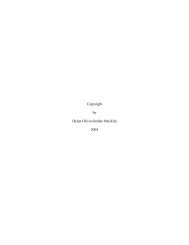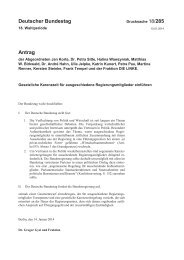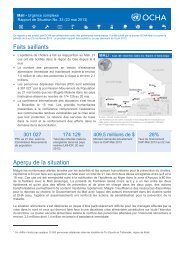saumel2012berlingardenproductscontamination
saumel2012berlingardenproductscontamination
saumel2012berlingardenproductscontamination
Create successful ePaper yourself
Turn your PDF publications into a flip-book with our unique Google optimized e-Paper software.
I. Säumel et al. / Environmental Pollution 165 (2012) 124e132 127<br />
or high traffic burden and barriers between plantings and streets exist; high: high<br />
traffic burden and barriers between plantings and streets are lacking); (b) traffic<br />
burden of the nearest road per day (tb; classification according to the number of<br />
vehicles per day including trucks and motorcycles from Berlin Department for Urban<br />
Development (2010): 1 (low) ¼5000; 2 ¼ 5001e10 000; 3 ¼ 10 001e15 000;<br />
4 ¼ 20 001e30 000; 5 ¼ 30 001e40 000; 6 (high) ¼ 40 001e50 000 vehicles per<br />
day); (c) distance to nearest road (d; in meters); and (d) presence or absence of<br />
barriers between planting sites and next street which might reduce airborne<br />
pollution [building (bb) or tall vegetation such as hedges or trees (bp)]. In addition,<br />
we recorded planting style (ps; crops planted in pots or directly in bed) and soil type<br />
(s; local soil or commercial garden soil).<br />
In total, we harvested 12 different horticultural crop species, which were<br />
randomly sampled at least at seven sites per crop species. The sampled vegetable<br />
types included fruits: tomato (Lycopersicon var. esculentum, N ¼ 28), green beans<br />
(Phaseolus vulgaris, N ¼ 7); root and stem vegetables: carrot (Daucus carota subsp.<br />
sativa., N ¼ 10), potato (Solanum tuberosum, N ¼ 13), kohlrabi (Brassica oleracea var.<br />
gongylodes L.; N ¼ 11); leafy vegetables and herbs: white cabbage (Brassica oleracea<br />
convar. capitata var. alba, N ¼ 7), nasturtium (Tropaeolum majus, N ¼ 7), parsley<br />
(Petroselinum crispum, N ¼ 7), chard (Beta vulgaris subsp. vulgaris var. cicla, N ¼ 7),<br />
basil (Ocimum basilicum, N ¼ 7), mint (Mentha spicata, N ¼ 8), thyme (Thymus vulgaris,<br />
N ¼ 7). In addition, for each crop we collected mixed samples of common<br />
supermarket products or, in the case of nasturtium, which was not available in<br />
supermarkets, from rural sites with nearly no traffic. We used these samples to<br />
compare the potential dietary exposure to trace metals of someone consuming<br />
urban horticulture products versus supermarket products.<br />
The edible parts of the vegetables were thoroughly washed before the plant<br />
samples were frozen after harvest. Prior to analyses, plant samples were mechanically<br />
crushed and dried at 105 C for 12e48 h depending on sample size. Dried<br />
samples were weighed and milled (0.15 mg/l, Atomic Absorption Spectrometer AAS1100B (PerkineElmer,<br />
USA) was used and for Pb, Cd, Cr and Ni and Cu concentrations 0.15 mg/l: 324.8/0.05 mg/l/AAS1100B;<br />
Cu < 0.15 mg/l: 324.8/4.0 mg/l/AA880Z; Pb: 217.0/3.0/AA880Z; Ni: 232.0/4.0 mg/l/<br />
AA880Z; Cr: 357.9/2,0mg/l/AA880Z.<br />
Biomass metal content, crop species, vegetable type and local settings were<br />
analysed by analysis of variance (ANOVA). The concentration of trace metals in the<br />
crop biomass was taken as the response variable and crop species, vegetable type<br />
and parameters which characterise the local settings (e.g., planting style, soil type,<br />
traffic burden per day, presence of barriers) were taken as explanatory variables.<br />
Normal distribution of data (ShapiroeWilk test) and homogeneity of data<br />
(BrowneForsythe’s test) were tested before applying ANOVA. Transformations were<br />
made if necessary to meet the assumptions of the residual normality and variance<br />
homogeneity needed for the analyses. We used Tukey test for comparison of means.<br />
In general, treatment effects were considered significant at the p < 0.05 level. All<br />
statistical analyses were done using R version 2.9.0 (R Foundation for Statistical<br />
Computing, Vienna, Austria).<br />
3. Results<br />
The trace metal contents differed widely among crop species<br />
(Table 1) and in relation to site characteristics (Table 2). Only a few<br />
samples had concentrations below the detection limit of 10 ppm<br />
(three for Ni and one for Cr and Cd). We revealed significant<br />
differences in Zn, Pb, Cr and Cd concentrations depending on crop<br />
species, parameters related to the mode of cultivation (planting<br />
style, soil type) and characteristics of the adjacent urban environment<br />
(local traffic burden, presence of buildings or vegetation as<br />
barriers between cultivation site and street). Yet in contrast to our<br />
expectations, we found no significant differences between vegetable<br />
types (Table 2).<br />
The Zn content in green beans, tomato, potato, kohlrabi and<br />
carrots was significantly lower than in leafy vegetables except<br />
white cabbage (Fig. 2A). The Cd content of kohlrabi and green beans<br />
was significantly lower compared to chard and parsley (Fig. 2B).<br />
The Pb content in tomatoes was significantly lower than in chard<br />
(Fig. 2C). The Cu content in mint and in chard was significantly<br />
higher than in all other species except basil and thyme. The lowest<br />
Cu contents were measured in white cabbage and green beans<br />
(Fig. 2D). Ni content in mint was significantly lower than in the<br />
Table 2<br />
ANOVA results of the crop species and site effects as well as the interactions between crop species and site effects on content of trace metals [in mg/kg biomass dry weight<br />
(DW)]. Minimum adequate linear models were chosen using a step-by-step reduction of the maximum model to find the minimum value of Akaike’s information criterion<br />
(AIC). The maximum model considered trace metal content of biomass [mg/kg DW] in relation to crop species (sp), vegetable type (vt), planting style (ps), soil (s), overall traffic<br />
burden (otb), number of vehicles per day on the nearest road (tb), distance (m) to the nearest road (d), barrier of buildings (bb) or barrier of plantings (bp) between crop and<br />
streets and relevant interactions between parameters. The model with the lowest AIC value was the full model minus vegetable type (vt), which had no effect on trace metal<br />
content of biomass: trace metal w sp ps s otb tb d bb bp. Degrees of freedom (df), mean squares (MS) and p values are given (***p < 0.001; **p < 0.01; *p < 0.05;<br />
ns, not significant).<br />
Content of trace metals in mg/kg DW<br />
Element Zn Pb Cu Ni Cr Cd<br />
Parameter p p p p p p<br />
Crop species (sp) 0.002**





